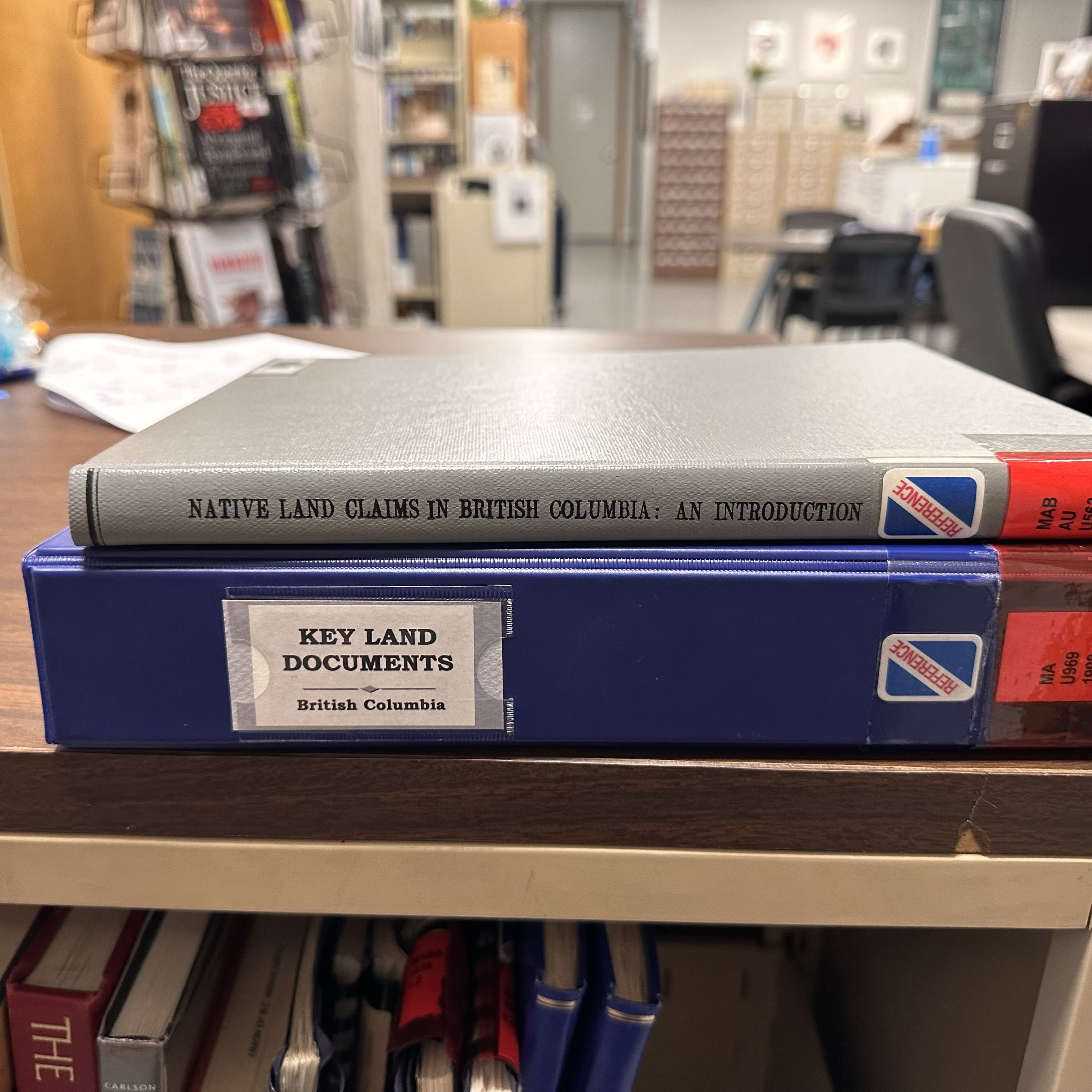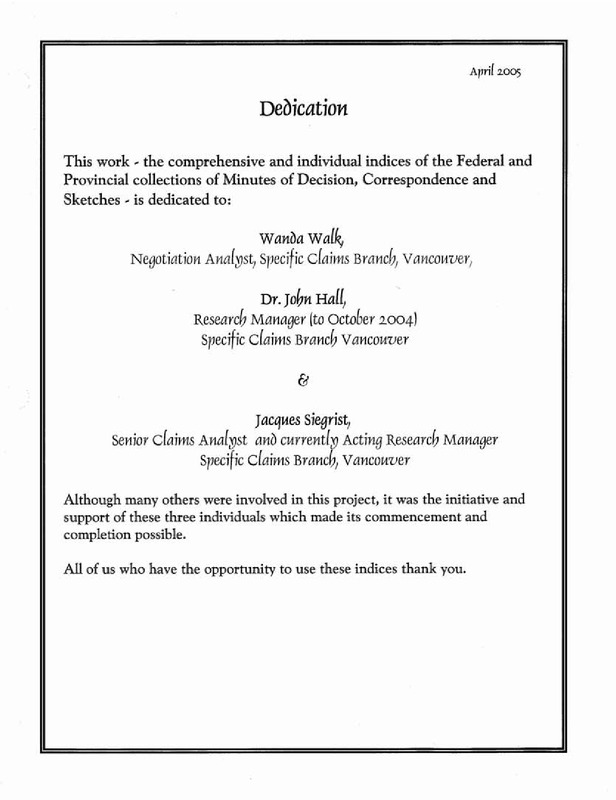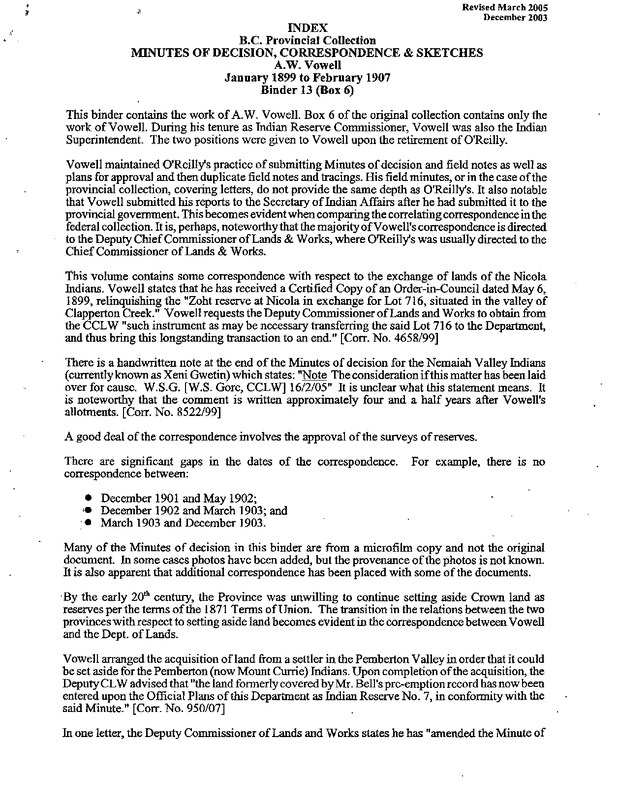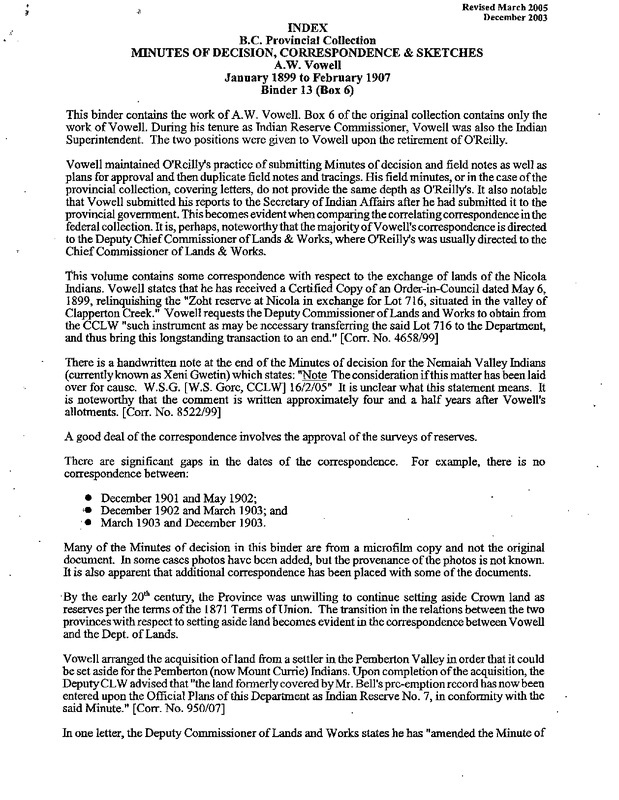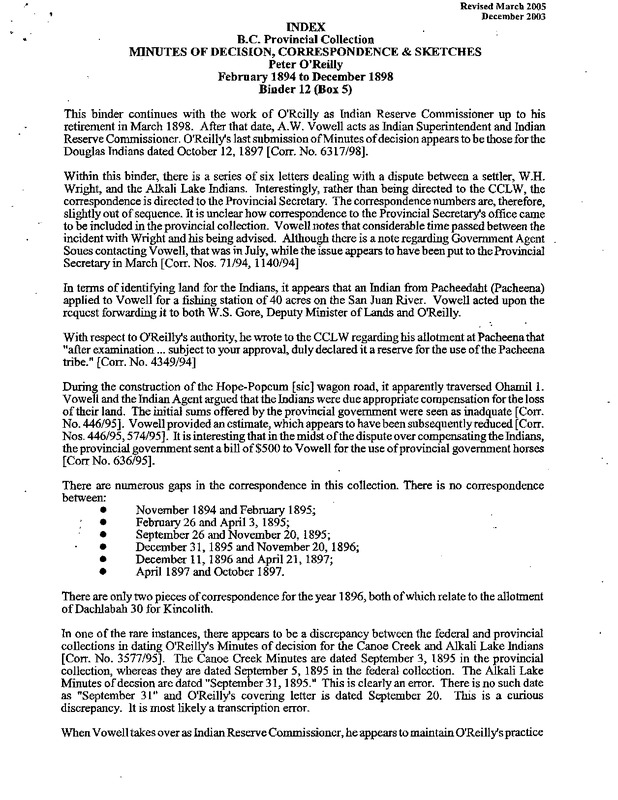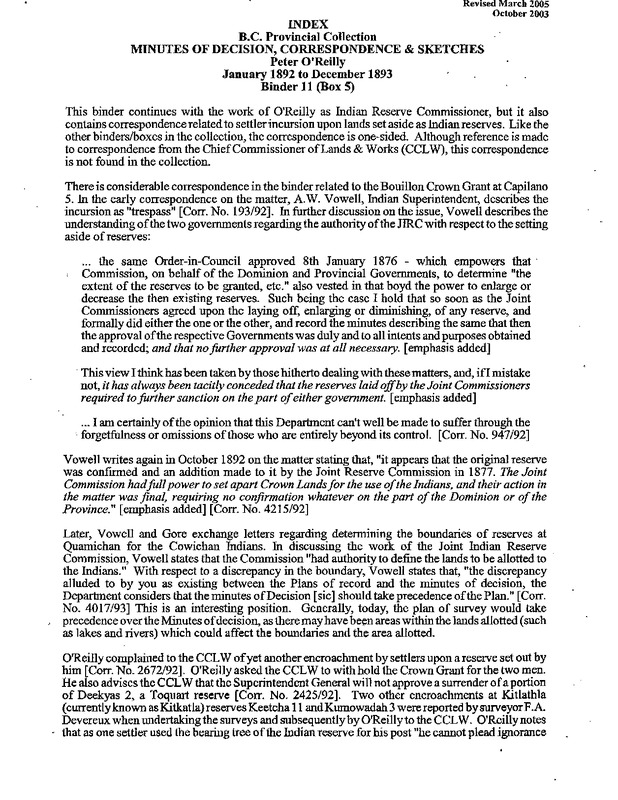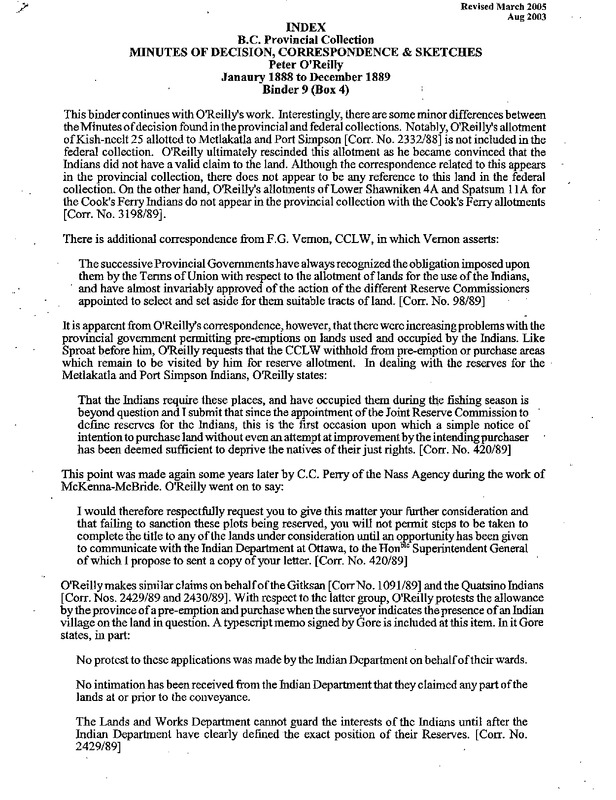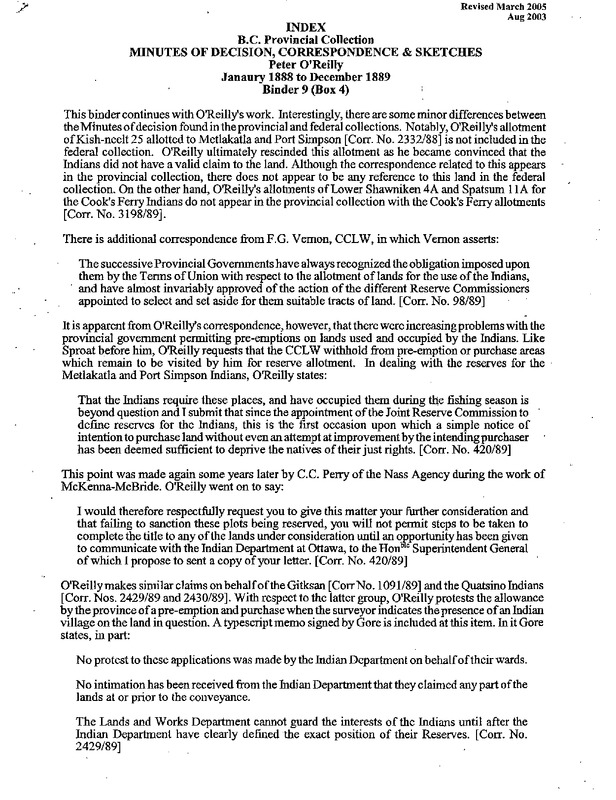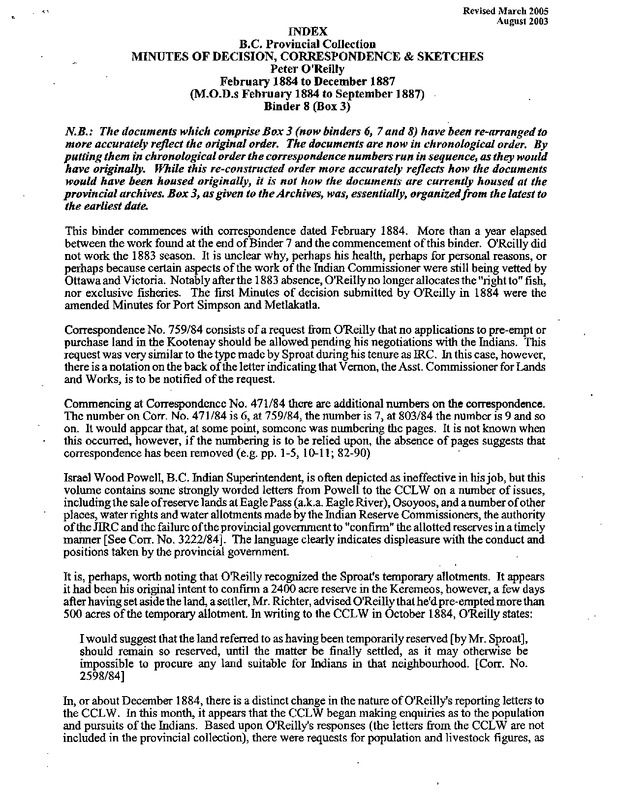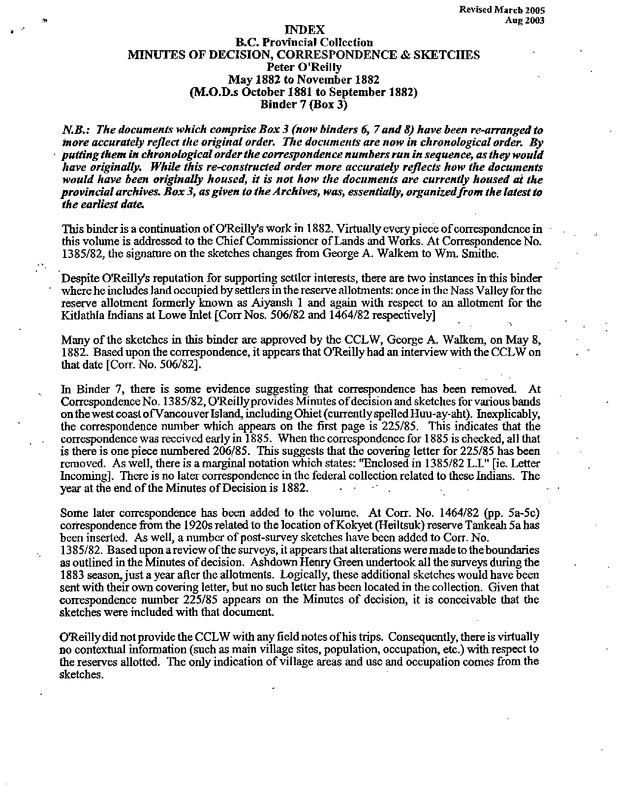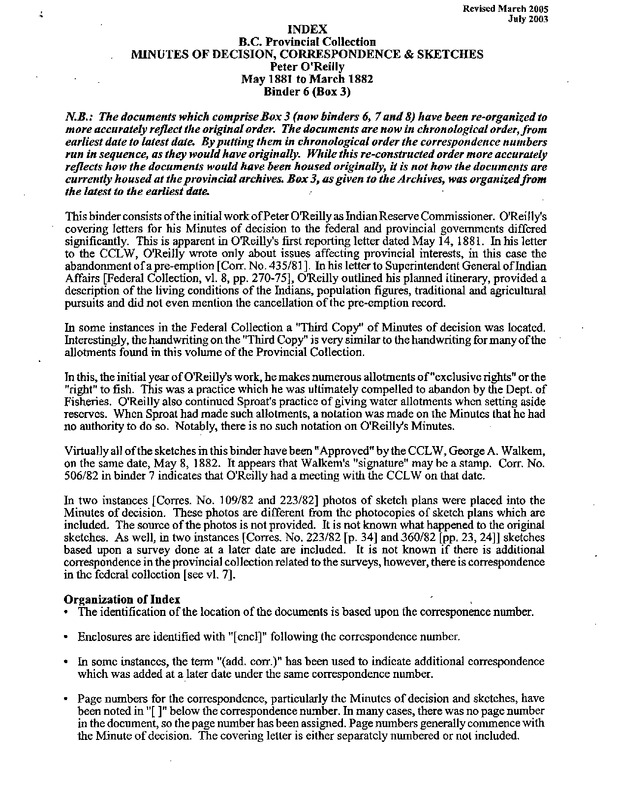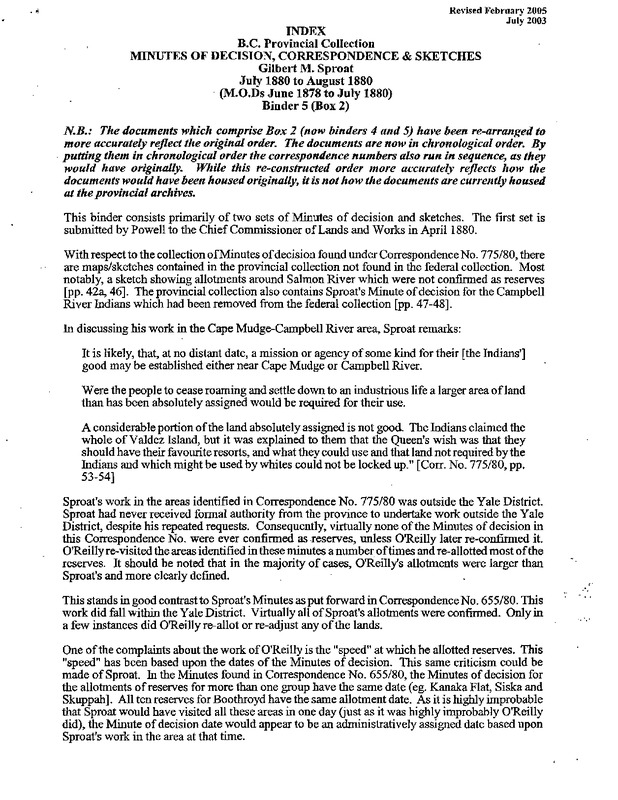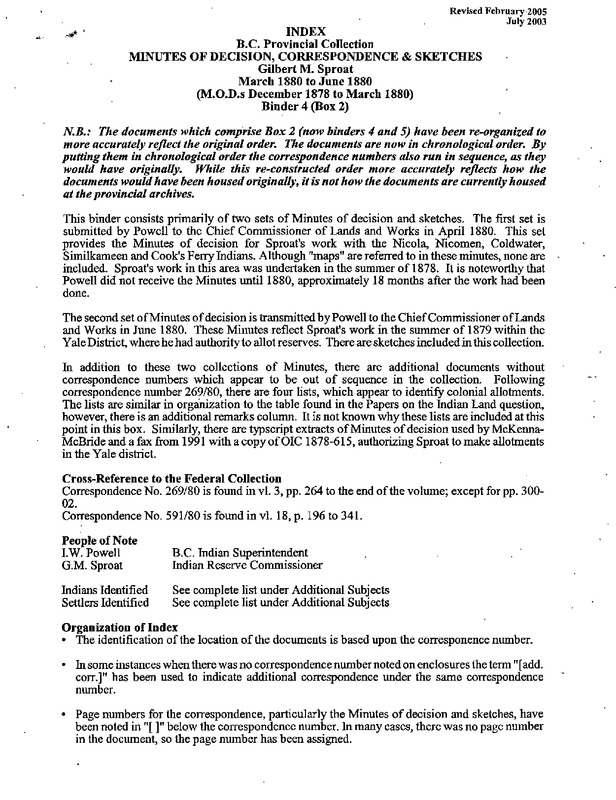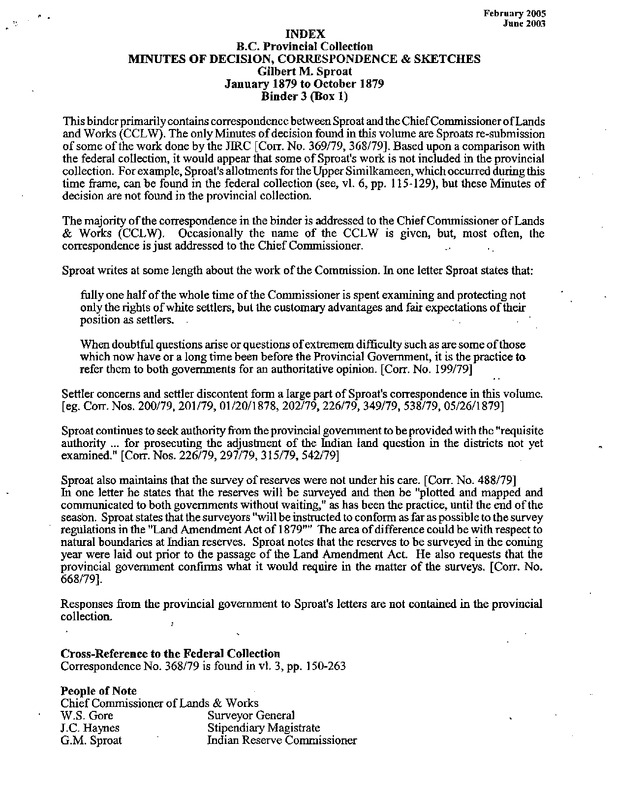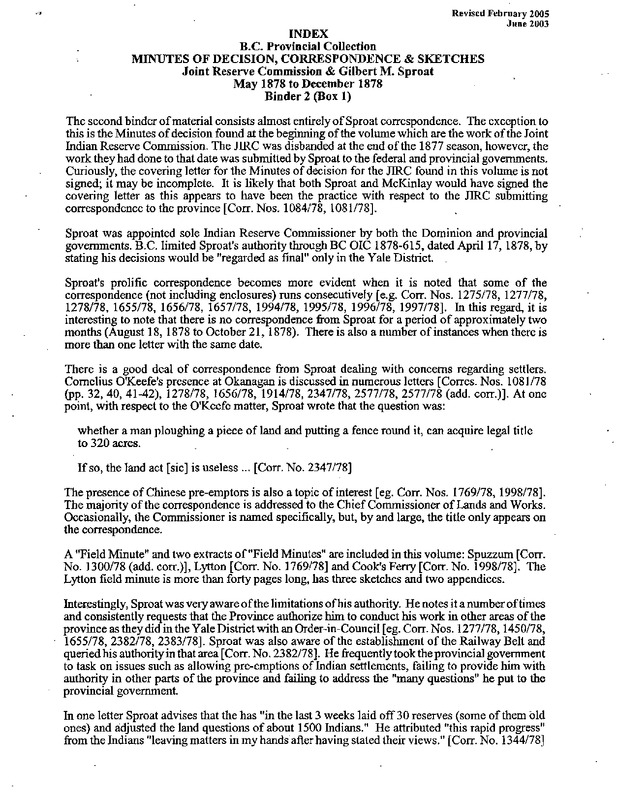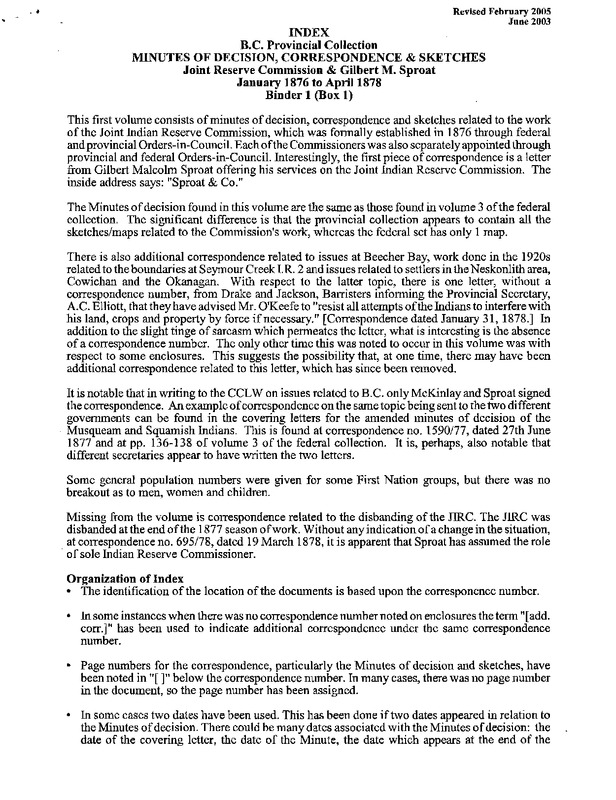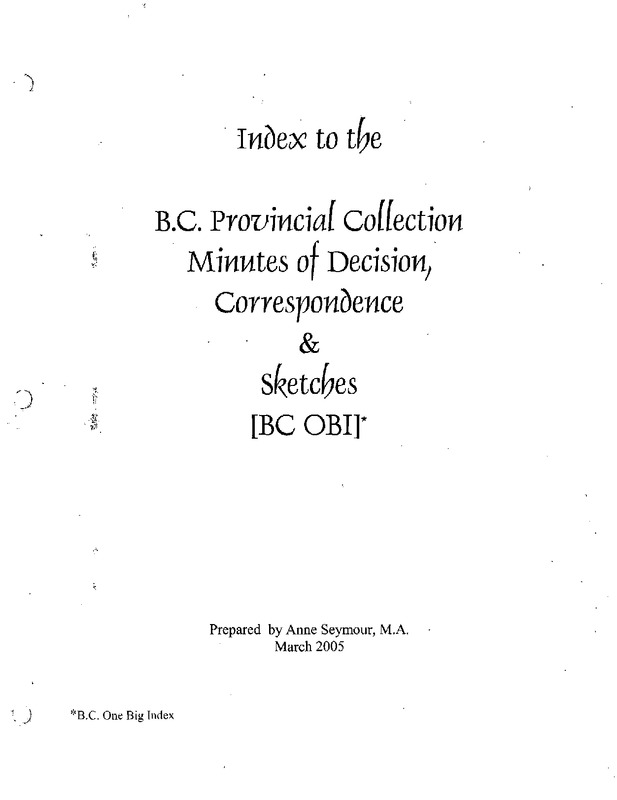Items
View as:
Peter O'Reilly
Peter O’Reilly was born March 27, 1827 in England to Patrick O’Reilly and Mary Blundell and was raised in Ireland. He was a Lieutenant with tie Irish Revenue Police until 1857. He Left Ireland in 1859 for Victoria. Shortly after his arrival he became the high sheriff of the colony where he was responsible for arranging the hanging of condemned criminals. He held this position until 1866.
O’Reilly was named assistant gold commissioner in 1860 for the Similkameen region and the Hope District. He administered the law in the gold fields, issued mining licenses, recorded claims and other duties. In 1862 he was named the chief gold commissioner for the province and was stationed in Richfield. While there he often worked with Judge Matthew Baillie Begbie who would remain his lifelong friend. As a result of the union of Vancouver Island and British Columbia in 1866 O’Reilly’s position was officially changed to become a county court judge. From 1864 to 1870 and then again in 1871 O’Reilly served on the Legislative Council of BC which was soon dissolved as a result of confederation. O’Reilly continued as county court judge for the Yale District for the next ten years until he learned of the opening of the position of Indian Reserve Commission in 1880. He travelled to Ottawa in hopes of securing the position. His family connection to Sir John A. MacDonald through his brother-in-law Joseph Trutch. For the next 18 years he would serve as the reserve commissioner.
O’Reilly’s reserve allotments have been criticized by current scholars as being inadequate and disregarding Aboriginal title. He also reduced the size of many reserves alloted by the the Joint Reserve Commission and his predecessor Gilbert M. Sproat. As a result of complaints from the Tsimshian regarding the reserves he laid out at Metlakatla in 1882 his reserve allotments were reviewed by provincial commission in 1884. O’Reilly claimed that when possible he had granted the Tsimshian’s requests in all of his decisions and the commission approved his allotments. and extent of reserves have been criticized by modern scholars. It has been suggested that he made niggardly allocations, and that because he had private investments in ranching operations he was sympathetic to ranchers generally, whose interests might conflict with the land requirements of Indians. Like most influential British Columbians of his time, he refused to accept the concept of aboriginal entitlement as a basis for claims. Later in his role as commissioner he did concede some rights in the areas of traditional hunting and gathering activities such as his promises to assure these rights to Chiefs in the Skeena and Bulkley regions.
O’Reilly retired from government service in 1898 to spend time at his home Point Ellice House in Victoria and enjoying his family’s social status. He died of heart failure at home where he lived with his daughter Kit on September 3, 1905.
References
Brealey, Ken. “Travels from Point Ellice: Peter O’Reilly and the Indian Reserve System in British Columbia” BC Studies No 115/6, (1997): pp. 181-236.
Harris, Cole. Making Native Space. Vancouver: UBC Press, 2002.
BC Archives, O’Reilly Family Papers.
Williams, David Ricardo. “Peter O’Reilly” Dictionary of Canadian Biography Online. University of Toronto, Universite Laval.
BC, Legislative Assembly, “Metlakatlah inquiry, 1884: report of the commissioners, together with the evidence” Sessional papers, 1885: 131–36.
Cail, R. E. Land, Man and the Law: The Disposal of Crown Lands in British Columbia, 1871–1913, Vancouver: UBC Press, 1974.
Gilbert Malcolm Sproat
Gilbert Malcolm Sproat was born to Alexander Sproat and Hectorine Shaw, 19 April 1834 in Scotland. In 1860 travelled to the Alberni Inlet on Vancouver Island as an employee of Anderson and Company. His encounters with Aht people of the Alberni Inlet led him to become an amateur ethnographer with the publication his book, Scenes and studies of savage life, published in 1868. Sproat Lake in the Alberni Valley is named for him. He married Katherine Ann Wigham in Victoria in 1862 and they raisd a daughter and two sons. They later separated from each other and she returned to England. Sproat was offered a seat in the colony’s legislative council but declined and later, on 24 July 1863, he was sworn in as a justice of the peace for Vancouver Island. He returned to England for a time, but he remained interested in BC affairs. In 1869 he allowed he name to be put forward for governor. After visiting BC in 1871, he assumed the role of the province’s first agent general to London.
In 1876 he returned to BC where he became the third member, representing both governments, of the Joint Indian Reserve Commission (JIRC). He completed two circuits with the JIRC before the commission was reduced and he was named as the sole commissioner in 1877. During his tenure as commissioner Sproat became increasingly critical of both governments’, especially the province’s, approach to Indigenous land issues. Sproat followed in Douglas’ views that the land should be reserved prior to settlement, that Aboriginal title needed to be acknowledged, and that reserves needed to include access to future commerce opportunities such as fishing, timber, agriculture etc. He voiced his numerous complaints regarding the failure of the province to deal with illegal settler pre-emptions, the resistance to recognize Aboriginal title, and the ramifications of the colonial policy to grant as little land as possible to reserves. He was instrumental preventing a possible war in the interior with the negotiation of reserves and dissolution of a Secwepemc/Okanagan Confederacy in 1877. His involvement and support of a large gathering of Nlha7kápmx, where the people met to plan forge a plan for self-government, and his continued letters of complaint to Ottawa and Victoria led to widespread criticism and eventually led to his resignation early in 1880.
In 1883 Sproat, as a government agent, was sent to the Kootenays to report on the region. As a result he became a magistrate in Revelstoke in 1885 and regional gold and land commissioner in 1886. He became known as “the Judge” and “the Father of the Kootenay.” In 1889 he ended his government service, remained in the interior, and became involved in real estate. In his later years, he returned to Victoria and he continued to express his opinions about the history of the province through his publications in newspapers and historical texts. His correspondence during his time as reserve commissioner stand as a voice of opposition to the disregard of Aboriginal rights, the unjust treatment of Indigenous people by the governments, and the “settlement” of BC. Sproat spent his last days in Victoria with Brenda Peers, James Murray Yale’s granddaughter, before his death on June 4, 1913.
References
Fisher, Robin. “An exercise in futility: the joint commission on Indian land in British Columbia, 1875-1880,” CHA, Hist. Papers, 1975: 79–94.
Foster, Hamar. “Gilbert Malcolm Sproat” Dictionary of Canadian Biography Online. University of Toronto, Universite Laval.
Harris, Cole. Making Native Space. Vancouver: UBC Press, 2002.
Sproat, Gilbert. Scenes and Studies of Savage Life Sproat. London : Smith, Elder, 1868.
Sproat, Gilbert. “Sir James Douglas, k.c.b.,” in the Victoria Week, 9 Sept.–11 Nov. 1911 (also preserved in clippings at pp.96–103 of the J. T. Walbran scrapbook at BCARS, S/S/W 14).
Sproat papers, BCARS, Add. mss 257.
Papers Connected with the Indian Land Question 1850-1875. Victoria, B.C. : Queen's Printer, c1987.
Rickard, T. A. “Gilbert Malcolm Sproat,” British Columbia Hist. Quarterly, 1 (1937): pp 21–32.
Federal Collection Minutes of Decision Correspondence & Sketches
This document contains the comprehensive and individual indexes of the Federal and Provincial collections of Minutes of Decision, Correspondence and Sketches. This index is sorted alphabetically and chronologically by the Band/Tribe name. Reserve names are the current names unless the reserve was not confirmed or was altered. Only reserves allotted between 1875 and 1908 are found in this index. Footnotes in the index will often detail name changes to reserves.
The entire index is full text searchable using the search box at the top of the PDF viewer. Once you have located a document by consulting the index, be sure to note the volume number and the page number.
Edward Mohun
Edward Mohun was born on September 3, 1838 in Chigwell England to Mr. and Mrs John Mohun. He arrived in Victoria in June of 1862. He was married to Emmeline Jane Newton (widow of W.H. Newton) in New Westminster in 1878. From 1863-1871 he worked as a surveyor throughout Vancouver Island, the Okanagan, Fraser Valley and Haida Gwaii. In 1871 and 1872 he was a the Canadia Pacific Railway Divisional Engineer of the “H Party” in charge of surveying the Yellowhead and Eagle Pass.
Mohun was appointed as a surveyor to the Joint Indian Reserve Commission in 1876. He surveyed reserve allotments throughout Vancouver Island and the coastal areas. In 1884, with the direction of the Honourable W. Smithe, Chief Commissioner of Lands and works, Mohun created a map of the Province of British Columbia. In 1885 he was involved in the large dyke and drainage projects in the Fraser Valley and from there he went on to designing the sewer systems in Vancouver and Victoria. In 1886 his research on BC wood products for bridge building resulted in the basis for future bridge calculations. In 1890 he was awarded the contract to be the chief engineer for the design of Victoria’s sewage system. In 1897 he received the “Gzowski Silver Medal” for his paper titled “The Sewage System of Victoria” presented before the Canadian Society of Civil Engineers”. The Victoria sewage system that he designed was considered state of the art at the time but is currently under scrutiny as a result of the sewage being deposited into the Strait of Jaun de Fuca.
Later in his career he was involved in sanitation and drainage projects in Victoria and the Vancouver - Pitt Meadows areas, a sanitation inspector, provincial railway inspector, and a public works engineer. He also held the position of Justice of the Peace for a period of fifteen years. In 1890 he was involved in the creation of the Professional Association of Land Surveyors in British Columbia along with fellow JIRC surveyor W.S. Jemmet and others, which resulted in Mohun’s unanimous election as its first president. The establishment of the association led to the establishment of the “Act Respecting Land Surveyors” which became law in APril of 1891 and placed authority for land surveying under the Chief Commissioner of Lands and Works. In 1898, he reported on the sanitation conditions in a number of town in the interior of the province and Vancouver Island.
Mohun passed away in October 1912 at his home at 618 Blanshard St., Victoria at 74 years of age. His name is remembered in Mohun Lake and Mohun Creek in the Sayward region and the Mohun Shoal on the mid-coast.
References
Allen, Robert W. “Edward Mohun, CE, LS: Surveyor of Railways, Indian Reserves, and the First President of the Association of Provincial Land Surveyors, British Columbia” The Link Vol. 23 no. 4, (October 2000): pp 14, 16.
Gordon, Katherine. Made to Measure: A History of Land Surveying in British Columbia. Vancouver: Sono Nis Press, 2006.
Captain William S. Jemmett
Captain William S. Jemmett was born in London England and is the som of William T. Jemmett. After serving fifteen years as an English army officer he came to British Columbia and joined the government survey service where he worked for twelve years including his service as surveyor with the Indian Reserve Commission. Gilbert Sproat had recommended Jemmett because he was “a quiet, discreet man who [would] not worry settlers, nor alarm the Indians” and because he had some experience in the interior as he was an early pioneer in the Agassiz area. In 1878 Jemmett was one of three surveyors, along with Edward Mohun and A.H. Green surveying reserve allotments throughout the province. Jemmett was assigned to the mainland reserves along with Green. In 1880 he was married to Miss F. Woods, the daughter of Archdeacon Woods of Victoria.
References
Allen, Robert W. “Edward Mohun, CE, LS: Surveyor of Railways, Indian Reserves, and the First President of the Association of Provincial Land Surveyors, British Columbia” The Link Vol. 23 no. 4, (October 2000): pp 14, 16.
Gordon, Katherine. Made to Measure: A History of Land Surveying in British Columbia. Vancouver: Sono Nis Press, 2006.
Preuss, Karl “British Columbia, and the Development of Indian Reserve No. 2 at Chuchuwayha”. BC Studies No. 162 (Autumn 2009): p. 87-121.
Scholefield, E.O.S., “Captain William S. Jemmett” British Columbia From the Earliest Times to the Present. Vancouver: S.J. Clarke Publishing Company, 1914.
Text
Binder 13
This binder contains the work of A.W. Vowell. Box 6 of the original collection contains only the work of Vowell, During his tenure as Indian Reserve Commissioner, Vowell was also the Indian Superintendent The two positions were given to Vowell upon the retirement of O'Reilly.
Binder 13
This binder contains the work of A.W. Vowell. Box 6 of the original collection contains only the work of Vowell, During his tenure as Indian Reserve Commissioner, Vowell was also the Indian Superintendent The two positions were given to Vowell upon the retirement of O'Reilly.
Text
Binder 12
This binder continues with the work of O'Reilly as Indian Reserve Commissioner up to his retirement in March 1898. After that date, A.W. Vowell acts as Indian Superintendent and Indian Reserve Commissioner. O'Reilly's last submission of Minutes of decision appears to be those for the Douglas Indians dated October 12,1897 [Corr. No. 6317/98].
Binder 11
This binder continues with the work of O'Reilly as Indian Reserve Commissioner, but it also contains correspondence related to settler incursion upon lands set aside as Indian reserves. Like the other binders/boxes in the collection, the correspondence is one-sided. Although reference is made to correspondence from the Chief Commissioner of Lands & Works (CCLW), this correspondence is not found in the collection.
Binder 10
The correspondence in this binder continues with O'Reilly's work on the west coast of Vancouver Island and into parts of the north. If any one theme becomes evident during these years, it is the ongoing attempts by the provincial government to alienate lands set aside as reserves. At Port Simpson, Kincolith, Vancouver Island, Vancouver at Capilano and in the Similkameen, settlers made claims which encroached either upon lands set aside as reserves, or upon lands used and occupied by the Indians which had not yet been dealt with by the Indian Reserve Commissioner. In each instance, O'Reilly writes to the CCLW advising him of the inappropriate action of the provincial officials in allowing pre-emptions and/or Crown Grants. Because the collection contains only O'Reilly's letters and not the responses from the CCLW, those responses can only be inferred based upon O'Reilly's letters
Binder 09
This binder continues with O'Reilly's work. Interestingly, there are some minor differences between the Minutes of decision found in the provincial and federal collections. Notably, O'Reilly's allotment of Kish-neelt 25 allotted to Metlakatla and Port Simpson [Corr. No. 2332/88] is not included in the federal collection. O'Reilly ultimately rescinded this allotment as he became convinced that the Indians did not have a valid claim to the land. Although the correspondence related to this appears in the provincial collection, there does not appear to be any reference to this land in the federal collection. On the other hand, O'Reilly's allotments of Lower Shawniken 4A and Spatsum 11A for the Cook's Ferry Indians do not appear in the provincial collection with the Cook's Ferry allotments [Corr. No. 3198/89].
Binder 08
This binder commences with correspondence dated February 1884. More than a year elapsed between the work found at the end of Binder 7 and the commencement of this binder. O'Reilly did not work the 1883 season. It is unclear why, perhaps his health, perhaps for personal reasons, or perhaps because certain aspects of the work of the Indian Commissioner were still being vetted by Ottawa and Victoria. Notably after the 1883 absence, O'Reilly no longer allocates the "right to" fish, nor exclusive fisheries. The first Minutes of decision submitted by O'Reilly in 1884 were the amended Minutes for Port Simpson and Metlakatla.
Binder 07
This binder is a continuation of O'Reilly's work in 1882. Virtually every piece of correspondence in this volume is addressed to the Chief Commissioner of Lands and Works. At Correspondence No. 1385/82, the signature on the sketches changes from George A. Walkem to Wm. Smithe
Binder 06
This binder consists of the initial work of Peter O'Reilly as Indian Reserve Commissioner. O'Reilly's covering letters for his Minutes of decision to the federal and provincial governments differed significantly. This is apparent in O'Reilly's first reporting letter dated May 14,1881. In his letter to the CCLW, O'Reilly wrote only about issues affecting provincial interests, in this case the abandonment of a pre-emption [Corr. No. 435/81 ]. In his letter to Superintendent General of Indian Affairs [Federal Collection, vl. 8, pp. 270-75], O'Reilly outlined his planned itinerary, provided a description of the living conditions of the Indians, population figures, traditional and agricultural pursuits and did not even mention the cancellation of the pre-emption record.
Binder 05
This binder consists primarily of two sets of Minutes of decision and sketches. The first set is submitted by Powell to the Chief Commissioner of Lands and Works in April 1880.
Binder 04
This binder consists primarily of two sets of Minutes of decision and sketches. The first set is submitted by Powell to the Chief Commissioner of Lands and Works in April 1880. This set provides the Minutes of decision for Sproat's work with the Nicola, Nicomen, Coldwater, Similkameen and Cook's Ferry Indians. Although "maps" are referred to in these minutes, none are included. Sproat's work in this area was undertaken in the summer of 1878. It is noteworthy that Powell did not receive the Minutes until 1880, approximately 18 months after the work had been done.
Binder 03
This binder primarily contains correspondence between Sproat and the Chief Commissioner of Lands and Works (CCLW). The only Minutes of decision found in this volume are Sproats re-submission of some of the work done by the JIRC [Corr. No. 369/79, 368/79]. Based upon a comparison with the federal collection, it would appear that some of Sproat's work is not included in the provincial collection. For example, Sproat's allotments for the Upper Similkameen, which occurred during this time frame, can be found in the federal collection (see, vl. 6, pp. 115-129), but these Minutes of decision are not found in the provincial collection.
Binder 02
The second binder of material consists almost entirely of Sproat correspondence. The exception to this is the Minutes of decision found at the beginning of the volume which are the work of the Joint Indian Reserve Commission. The JIRC was disbanded at the end of the 1877 season, however, the work they had done to that date was submitted by Sproat to the federal and provincial governments. Curiously, the covering letter for the Minutes of decision for the JIRC found in this volume is not signed; it may be incomplete. It is likely that both Sproat and McKinlay would have signed the covering letter as this appears to have been the practice with respect to the JIRC submitting correspondence to the province [Corr. Nos. 1084/78, 1081/78],
Binder 01
This first volume consists of minutes of decision, correspondence and sketches related to the work of the Joint Indian Reserve Commission, which was formally established in 1876 through federal and provincial Orders-in-Council. Each of the Commissioners was also separately appointed through provincial and federal Orders-in-Council. Interestingly, the first piece of correspondence is a letter from Gilbert Malcolm Sproat offering his services on the Joint Indian Reserve Commission. The inside address says: "Sproat & Co."
B.C. Provincial Collection Index
This document contains the index to the B.C. Provincial Collection of Minutes of Decision, Correspondence and Sketches. This index is sorted alphabetically and chronologically by the Band/Tribe name. Band names are as found in the collection. The Reserve name is the current name unless the reserve was not confirmed or was altered. Only reserves allotted between 1875 and 1908 are found within this index. Footnotes in the index will often detail name changes to reserves.
The entire index is full text searchable using the search box at the top of the PDF viewer. Once you have located a document by consulting the index, be sure to note the binder number, correspondence number (corr. no.) and page number.
Ashdown Henry Green
A.H. Green was born August 18, 1840 London England. He studied Civil Engineering in England with plans to work there but health problems resulted in doctor’s recommendation for a cooler climate. He arrived in Victoria on Vancouver Island in August 23, 1862 and never returned to England. He became a partner with F.W Green , no relation, the City Surveyor (now called City Engineer). In 1865 he explored Selkirk Mountain range to locate a government road to pre-confederation Canada. He kept a diary of this expedition which is available at the BC Archives. October 1865 received orders from Joseph Trutch and Dewdney to return to Victoria.
In the late 1860’s he settled in the Cowichan Valley on a farm near Somenos Lake where he was a founding member of the Cowichan Lending Library and Library Institute. From 1871 to 1880 he was appointed Divisional Engineer for the CPR working on the location of the CPR line across BC. Through 1974 and 1975 Green surveyed Saltspring Island and in 1879 he married Miss caroline Guillod of Comox. The couple moved to Victoria and had two children; Caroline and Ashdown Thomas. Mrs Green died in 1883 and the children were sent to England to be raised by Mr. Green’s brothers. They later returned and settled in Duncan in 1903.
In 1878 Green set out to survey reserve allotments as part of the Joint Indian Reserve Commission along with Edward Mohun and W.S. Jemmet. He appears to have at times also held the role of negotiator when arriving to survey land to find that had been set out by commissioners but the survey created more specific boundaries. His curiosity sometimes cause him inconvenience as demonstrated in 1906 when his queries about how a Nass woman shaped her head through binding was interpreted as a threat and the response was to guard the woman when he was present. He continued as a surveyor for the reserve Commission throughout its existence and in 1913 was appointed as technical officer to the McKenna-McBride Royal Commission on Indian Affairs.
In 1888 Green married Constance Clara Augusta Dumbleton of Victoria had three sons, one of whom died in infancy. Sometime before 1894, the Green’s moved to Duncan where Mrs Green became very active in the social life while Henry was traveling with the reserve Commission. Green was an avid sport fisherman and published several fishing articles in the Journal of Natural History on fish species. He identified nine species previously not see in BC and discovered 2 species that were previously unknown; Lake Chub and Lobefin Snailfish.
The BC Museum currently has a collection of his preserved fish. He was also known for tying fishing flies. His steamer trout fly, called the Ashdown Green, was regularly featured on the back of packages of Sportsman cigarettes. The Green’s moved back to Victoria in 1913 to Mrs Green’s family home in the Rockland area of Victoria. Green retired as a surveyor in 1918 and passed away in 1927.
References
Gordon, Katherine. Made to Measure: A History of Land Surveying in British Columbia. Vancouver: Sono Nis Press, 2006.
Green, J.W. Ashdown “A brief Account of the Life of Ashdown Green 1840-1927; Civil Engineer, Land Surveyor, and Amateur Ichthyologist” Corporation of Land Surveyors of the Province of British Columbia Biographies September 20, 1984 MS-2259 - Box 10, file 12 BCA.
Harris, Cole. Making Native Space. Vancouver: UBC Press, 2002.
Paterson, Tom W. “Green Trooped Through B.C. - Inch by Inch” The Link July (1999): pp 28-20.
BC Archives MS 0437:
Survey Journal Howe Pass, CPR 1871.
Journal of Columbia River Exploring Party 1865.
Diary of Ashdown H. Green CPR Survey Party “S” Han. 31 1872- Oct. 28, 1873.
Ashdown H. Green, Diary of A Survey of Salt Spring Island June 8-Nov 22 1874.
Arthur W. Vowell
A.W. Vowell was born in Ireland on September 17, 1941 to Richard and Elizabeth Vowell as the twelfth of thirteen children. He joined the Irish militia where he served in garrison duty in England until 1860. Vowell arrived in Victoria via the ship Isthmus of Panama through San Francisco in 1861 and headed for the gold mines of the Cariboo. He tried for a time, without success, to succeed in his endeavors until he exhausted his resources and returned to the coast where he took up manual labour.
Vowell joined the civic service in 1864 and was appointed as a Chief Constable in 1866 and then became the gold commissioner of the Kootenay district. In 1873 he was transferred to the Omineca District and in 1874 to the Cassiar District where new gold was found. He left the public service in fall of 1874 and was elected a member of the provincial legislative assembly as senior representative from the Kootenay District. He left his seat in the legislature in 1876 and returned to the Cassiar gold fields as a commissioner and stipendiary magistrate until 1884 when he was transferred to the Kootenay District until 1889. In 1898 he took over the position of Superintendent of Indian Affairs for the province of BC from I.W. Powell. When Vowell accepted the position relations between the provincial and federal governments were tense and adversarial. The position of reserve commissioner had also been folded into that of the Indian Superintendent. The province viewed the federal government and Vowell’s office as interfering with the province’s Indian land policies. In his early years he allotted reserves in the north eastern regions of the province in the Nass, Bella Coola, and Chilcotin regions. Under Vowell’s management the situation became unmanageable when in 1907 the province refused to approve the allotment of any more reserve lands. During his tenure he had little ability to maneuver given the position of the provincial government but tried his best to continue reserve allocation. If the Chief Commissioner of Lands and Works did not approve his allotments there was little he could do. With relations between the governments continuing to dissolve Vowell resigned in March 1910 and was the last to allocate reserves before the McKenna-McBride Commission.
In addition to this role he was requested for special assignment to bring law and order to the city of Vancouver during riots and racial tension in 1887. He took charge of the municipal government with the aid of an inspector and forty constables to restore order to the city. He was a member of the Royal Arch Masons and also belonged to the pioneer society. He died in 1918.
References
Gosnell, R.E. A History of British Columbia. Victoria [?]: Hill Binding Co, 1906.
Archibald McKinlay
Archibald McKinlay was born in 1811 in Killin, Perthshire, Scotland. He entered the service of the Hudson's Bay Company as an apprentice clerk at York Factory in 1832. His service with the Hudson’s Bay company includes: Clerk in charge of the Forks, Red River Settlement, 1834; Columbia District, 1835; Clerk, New Caledonia District, 1836 to 1838; Clerk, Bona Ventura expedition, 1839 to 1840; Clerk in charge of Fort Walla Walla, 1841 to 1846; Chief trader and charge of Wallamette Falls 1846. He was on leave from 1849 to 1850 and retired from the HBC in 1851 remaining in Oregan with his wife Sarah Julia Ogden, daughter of Peter Skene Ogden, whom he married in June 1840 and their five children.
After his HBC service he created the firm of Allan, McKinlay & Co. in Oregon City with G.T. Allan and Thomas Lowe. They operated as an agent of the HBC in Willamette Falls until severe flooding in December 1860 left the business in ruins. In 1862 McKinlay moved his family to Lac La Hache, where Sarah’s father Ogden had settled, and pre-empted 160 acres of land. They established a ranch and Roadhouse at 115 Mile that catered to travellers moving through on the Cariboo Road.
In 1876 he was named as one of the commissioners of the Joint Indian Reserve Commission, along with A.C.Anderson and G.M.Sproat. McKinlay was the provincial representative. He was not supportive of the Dominion’s involvement in the commission as he felt that it was the province who had the right to allocate the land rather than the Dominion. In his commission diary he complained about Anderson, the Dominion representative, not listening to his provincial address when meeting with Native leaders. He also strongly disagreed with his fellow commissioners when they sided with the Okanagan people when two ranchers O’Keefe and Greenhow had illegally pre-empted land at the north end of Okanagan Lake. Sproat granted the land to the Okanagan’s for their reserve. McKinlay had privately instructed the ranchers not to cooperate with the commission. McKinlay, a settler himself, placed the settlers interests ahead of the Okanagan’s reserve needs. The JIRC was disbanded and reduced to a single commission with G.M. Sproat in 1878.
McKinlay returned to his ranch at 115 Mile. Ironically, when preparing for retirement McKinlay requested a survey of his property and found that his pre-emption had never been registered. He had submitted the papers to Judge Baily Begbie but they were never processed. He also neglected to apply for a certificate of improvement which is the next necessary step. In 1878 a Crown land grant for 700 acres was issued October 17, 1878 thus resolving the issue. He lost his eldest son James when he was robbed and murdered on his return trip from the coast where he had sold a band of horses. He spent later retirement years with his wife at their daughter Darah Fergason’s at Savona BC. until his death in 1919.
References
Harris, Cole. Making Native Space. Vancouver: UBC Press, 2002.
McKinlay, Archibald and Hubert Howe Bancroft. "Narrative of a Chief Factor of the Hudson's Bay Company." BC Archives, 1878.
Patenaude, Branwen C. Trails to Gold Volume 2. Victoria: Horsdal & Schubart, 1995.
Patenaude, Branwen Golden Nuggets: Roadhouse Portrait’s Along the Cariboo Gold Rush. Surrey: Heritage House, 1998.
Biographical sketch of Archibald McKinlay. Hudson’s Bay Company Archives, Archives of Manitoba Keystone Archives Descriptive Database.
Alexander Caulfield Anderson
Alexander Caulfield Anderson was born to Robert Anderson and Eliza Charlotte Simpson in India on March 10, 1814. He was raised in Essex, England before joining the Hudson’s Bay company in March 1831 with his brother James and sailing to Canada. He remained with the HBC from 1832 to 1854 where he worked for Peter Skene Ogden, was appointed to numerous forts in New Caledonia and what is now Washington State. In 1837 he married Eliza Birnie, daughter of an HBC clerk, with whom he had 13 children. He was based at Fort Alexandria on the Fraser River from 1841-1848 and from there led three expeditions to explore trade routes from Kamloops to Fort Langley. These expeditions, with the assistance of a Native guide “Blackeye”, resulted in the path via the Coquihalla and Tulameen rivers that was used as the brigade trail from 1849 to 1860. He had the charge of Fort Colville until 1851 when he was stationed at Fort Vancouver. He retired from the HBC on 1 June 1854, age 40, to Clamath Washington near his wife’s family.
At the start of the gold rush in 1858 Douglas requested that he modify this HBC brigade trail for use by the miners and it became known as the “Douglas Trail”. He then moved to Victoria Vancouver Island where he became the first Collector of Customs. His dealings in Victoria include part owner of Victoria Steam and Navigation Company, and Dominion inspector of fisheries for BC. In 1876 Anderson was the first commissioner appointed to the Joint Indian Reserve Commission representing the Dominion Government along with Archibald McKinlay and Gilbert M. Sproat. In each meeting with Native leaders he would deliver the address from the Dominion government. He was involved, with McKinlay and Sproat in the negotiating the dissolution of a Secwepemc/Okanagan Confederacy in 1877 which possibly prevented a war in the interior. He completed two circuits with the JIRC before disagreements between the provincial and Dominion governments and budget concerns saw the commission reduced to Sproat as a single commissioner in early 1878. He shared many of the same sentiments as Sproat and was frustrated the by province’s attempts to impede the commission and impose a settler-supportive agenda.
Anderson had numerous publications as an author on BC topics, some of his publications include a guide for gold-miners in 1858 Hand-book and map to the gold region of Frazer’s and Thompson’s rivers; an award winning essay in 1871 “The dominion at the west; a brief description of the province of British Columbia”; A brief account of the province of British Columbia, its climate and resources; an appendix to the British Columbia directory, 1882–83; and he contributed a manuscript to Hubert Howe Bancroft’s History of British Columbia titled “History of the northwest coast.” Bancroft considered him to be the “most scholarly” in all the HBC. He died May 8, 1884 in Saanich BC. Anderson Lake, Anderson River and Anderson Island in Puget Sound Anderson were named after him.
References
Bancroft, H. H. History of British Columbia, 1792–1887. San Francisco, 1887.
Creech, E.P. “Similkameen trails, 1846–61,” BCHQ, 5 (1941): pp 256–62.
Fisher, Robin. “An exercise in futility: the joint commission on Indian land in British Columbia, 1875-1880,” CHA, Hist. Papers, 1975: pp 79–94.
Goodfellow, J. C. “Fur and gold in Similkameen,” BCHQ, 2 (1938): pp 72–76.
Harris, Cole. Making Native Space. UBC Press: Vancouver, 2002.
Hatfield. H. R. “On the brigade trail,” Beaver, outfit 305 (summer 1974): pp 38–43.
Lamb, Kaye W. “Alexander Caulfield Anderson” Dictionary of Canadian Biography Online. University of Toronto, Universite Laval.

